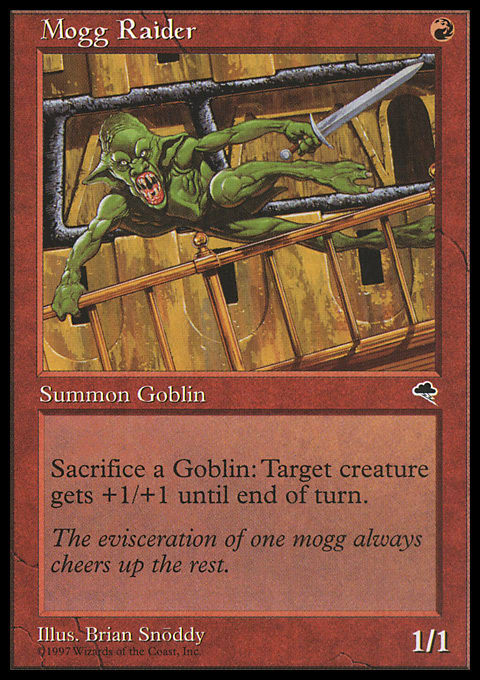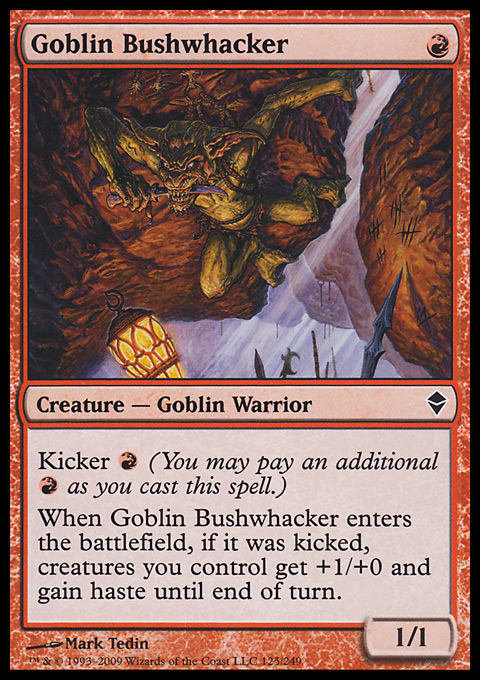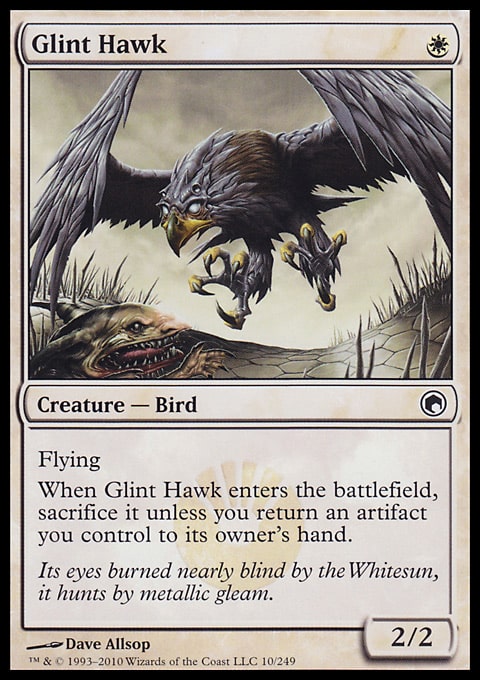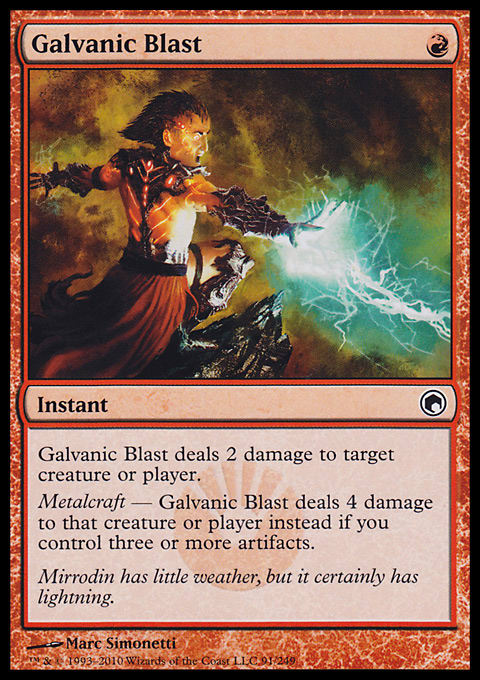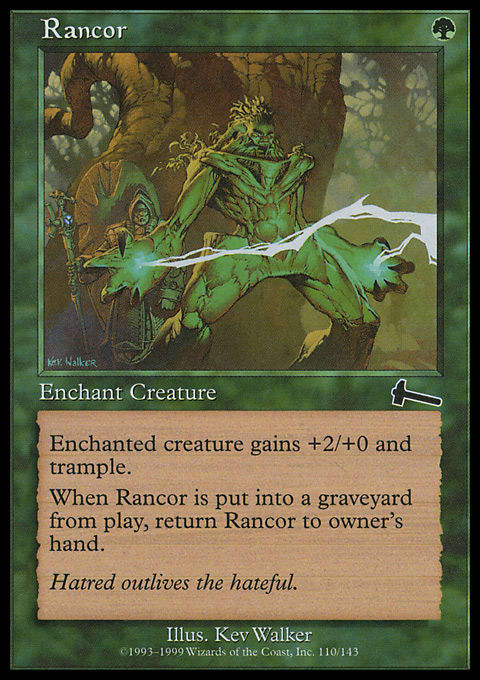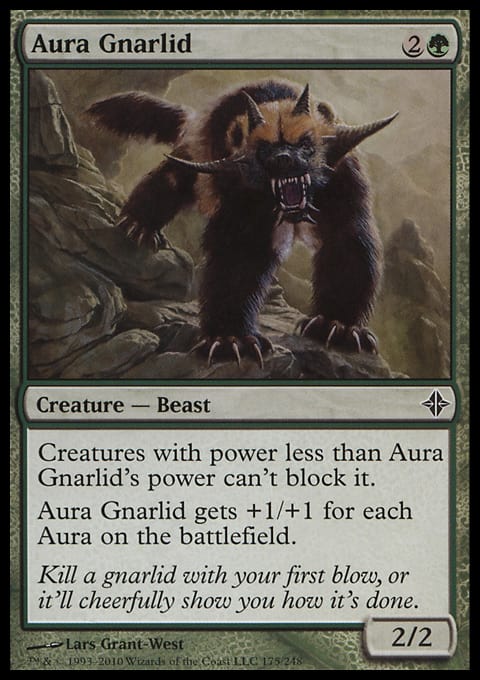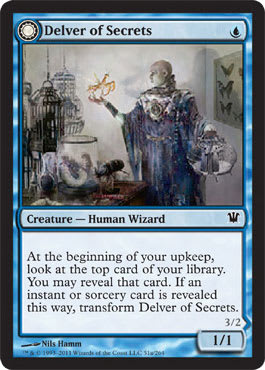Last time I introduced you to Pauper and the foundation of the format. Today I want to talk about aggro decks and their place in the metagame. I’m starting with this portion of the metagame because in Pauper it is easier to be the aggressor than to try and stall the threats. Magic has a history of stronger creatures at common which lends itself to beating down. Cards that make aggressive strategies better like burn and pump spells also appear in that rarity slot. On the other side of the coin, Planeswalkers, board wipes, and other sources of massive swings in card economy are absent which makes it easier for creatures to define matchups.
Like their namesake in other formats, Pauper aggro decks are designed to end games quickly and strand cards in the enemy’s hand. These decks try to run creatures with high power to cost ratios while also including cards that can increase the potential damage output of the deck. Broadly defined as reach — the ability to close out a game — there is no shortage of these cards in the format. The first aggro deck to have a measure of success was Goblins. While the Red deck has since fallen from its pedestal it is an important case study in understanding what makes aggressive decks work in the format.
Goblins ? Pauper circa 2011 | Proposed Pauper Deck, Alex Ullman
- Creatures (35)
- 3 Sparksmith
- 4 Goblin Arsonist
- 4 Goblin Bushwhacker
- 4 Goblin Cohort
- 4 Goblin Sledder
- 4 Mogg Conscripts
- 4 Mogg Flunkies
- 4 Mogg Raider
- 4 Mogg War Marshal
- Instants (8)
- 2 Death Spark
- 2 Fireblast
- 4 Lightning Bolt
- Lands (17)
- 17 Mountain
It may not look like much now, but at its height Goblins was the premier deck in Pauper. At the time Tendrils of Corruption helped to define the metagame and the presence of Goblin Sledder and Mogg Raider negated the strength of the Time Spiral instant. Tendrils would often take away a turn in that it traded for a threat while also bolstering the caster’s life total — about a turn’s worth of work. Goblins turned this trade on its ear by running threats that were not profitable trades for the 4 mana spell and maintained the ability to turn off the life gain with its sacrifice outlets.
These same sacrifice outlets provided a way to deal extra damage. Mogg War Marshal’s Echo appears to be a liability in a land light list but with a Raider or Sledder you can sacrifice with the trigger on the stack to deal an additional point of damage while committing another body to the board. The duo also made Death Spark stronger.
Death Spark is one of those sticky wickets in Pauper in that it is not a common in paper but was at one point an important card online. Death Spark provided a recurring source of damage that could take out a quarter of a life total in a longer game. Death Spark also provided defense for the deck against Counterspell and its ilk — just cast it in response to your creature getting targeted on the stack — and would peck in for the final points of damage. At the height of popularity the best Goblins pilots could be discerned from their management of Death Spark.
Goblin Bushwhacker provided a true force multiplier that could win games off the top but the presence of Lightning Bolt and Fireblast are what really shrunk the game. Goblins could apply pressure early and if it needed to could win the game despite the opponent feeling they were at a safe life total. It was not any one of these cards that made Goblins great but rather how they worked together.
So why did Goblins fall off the radar? While the deck still pops up from time to time the format has largely passed the deck by. Tendrils of Corruption hardly defines Pauper anymore — it sees fringe play at best. Creatures have gotten marginally better and while Goblins has seen upgrades in Foundry Street Denizen and Goblin Heelcutter they do not hold a candle to what other decks have gone. Yet these factors alone are not enough to keep Goblins down. Instead it is the stagnation of the deck’s reach. The Khans of Tarkir Gain Lands have made it easier for decks to start the game at around 22 life and while Goblins was excellent at dealing 20 damage it struggles with trying to eke out the few extra points. Similarly Goblins is not able to run cards better than Lightning Bolt and Fireblast. Taken together, aggressive strategies have moved on from this vanguard.
Kuldotha Tokens ? Pauper | swiftwarkite2, 5-0 Pauper League
- Creatures (12)
- 4 Glint Hawk
- 4 Kor Skyfisher
- 4 Thraben Inspector
- Instants (10)
- 2 Rally the Peasants
- 4 Galvanic Blast
- 4 Lightning Bolt
- Sorceries (7)
- 1 Firebolt
- 3 Battle Screech
- 3 Kuldotha Rebirth
- Enchantments (2)
- 2 Journey to Nowhere
- Artifacts (8)
- 4 Ichor Wellspring
- 4 Prophetic Prism
- Lands (21)
- 1 Plains
- 2 Forgotten Cave
- 2 Radiant Fountain
- 2 Secluded Steppe
- 2 Wind-Scarred Crag
- 4 Boros Garrison
- 4 Ancient Den
- 4 Great Furnace
- Sideboard (15)
- 2 Circle of Protection Red
- 2 Electrickery
- 2 Gorilla Shaman
- 4 Molten Rain
- 3 Pyroblast
- 2 Standard Bearer
If we want to talk about reach then we have to start with the newest deck on the block. Kuldotha Tokens is an evolution of midrange Boros and Jeskai Metalcraft decks that would use Prophetic Prism and Ichor Wellspring to fuel Kuldotha Rebirth, Glint Hawk, and Galvanic Blast. These decks were able to win early but more often than not they dragged the game and won on the back of flying creatures and a robust burn suite. The printing of Thraben Inspector and the downshift of Rally the Peasants changed the clock. The 1-drop made it easier to support Battle Screech which in turn allowed the deck to start assailing a life total earlier in the game. The added reach of Rally the Peasants does four times the work of a single Goblin Bushwhacker. Kuldotha Tokens is far from a pure aggro deck but it has some of the best reach available in the format and more than one game has ended in a flurry of Bolts and Blasts.
Kuldotha Tokens and Goblins have some major similarities in their ability to produce multiple threats from one spell, their reach, and their ability to go wide and tall. They diverge in two significant ways. First, Kuldotha Tokens has increased ability to see new cards. Between the Onslaught cycle lands, Prophetic Prism, Ichor Wellspring, and Thraben Inspector, the Boros deck, while hard pressed for true card advantage, has the ability to see a ton of cards. Even when Goblins decks adopted Goblin Matron they were not able to approach the level of Kuldotha Tokens.
The other big difference is how they deal damage. Goblins operates at Lightning Bolt efficiency and deals damage in chunks of three with ease. Goblin Bushwhacker could take a 2 power creature and give it a healthy boost; Mogg War Marshal is 3 power worth of creatures. Kuldotha Tokens takes Lightning Bolt and dials it up to eleven.
That is, if eleven is four.
Galvanic Blast changes the math of aggressive strategies. Looking at Kuldotha Tokens it is far easier to get the job done since its spells deal with 20% of a life total instead of 15%. Battle Screech deals four; Kor Skyfisher and Glint Hawk in tandem deal four; Rally the Peasants deals an additional four for each creature. If you want to identify the difference between Pauper aggro in at the start of the decade and now it can be summarized as the difference between Galvanic Blast and Lightning Bolt.
Plotting the decks of Pauper on the X-axis of aggressiveness and we’d see Kulodtha Tokens end up toward the middle, approaching the midrange realm. The next deck comes closer to the origin point.
Stompy ? Pauper | TinyTim123, 5-0 Pauper League
- Creatures (26)
- 2 Basking Rootwalla
- 2 Vault Skirge
- 3 River Boa
- 3 Wild Mongrel
- 4 Nettle Sentinel
- 4 Quirion Ranger
- 4 Skarrgan Pit-Skulk
- 4 Young Wolf
- Instants (11)
- 1 Hunger of the Howlpack
- 2 Mutagenic Growth
- 4 Groundswell
- 4 Vines of Vastwood
- Sorceries (1)
- 1 Epic Confrontation
- Enchantments (4)
- 4 Rancor
- Artifacts (1)
- 1 Bonesplitter
- Lands (17)
- 17 Forest
- Sideboard (15)
- 2 Epic Confrontation
- 3 Feed the Clan
- 3 Gleeful Sabotage
- 2 Gut Shot
- 2 Relic of Progenitus
- 3 Scattershot Archer
Stompy is a lovely beatdown build. It runs the bare minimum of lands while also resetting land drops with Quirion Ranger. It is resilient to removal thanks to Vines of Vastwood and Young Wolf. It also is optimized to deal damage in Galvanic Blast sized chunks. Vines doubles as a strong pump spell while Groundswell goes over the top of Giant Growth. Hunger of the Howlpack may only grant three extra power but that bonus sticks around. Finally Rancor makes every Shock into a Fireblast and helps the deck end games.
Stompy is a pure aggro deck in the vein of Goblins. It’s card advantage comes less through raw cards and more by rendering opposing spells impotent. Stompy is fairly flexible in its composition in that it can swap 2-drops for a perceived metagame. River Boa, Mire Boa, Garruk's Companion, Nest Invader, and Silhana Ledgewalker are all correct in different contexts. Stompy also has the advantage of having multiple strong 1-drops which is vital for overcoming the baseline deck of the format (Delver). Having a strong suite of anti-flying sideboard cards does not hurt.
Stompy is a study in mana efficiency but has an upper limit on offensive output. While I think it is a better deck than Kuldotha Tokens, despite the latter’s ability to deal more damage, there is another Rancor deck that looks for a more permanent solution to dealing with life totals.
Hexproof ? Pauper | JamesFrancisMTG, 5-0 Pauper League
- Creatures (16)
- 4 Aura Gnarlid
- 4 Gladecover Scout
- 4 Silhana Ledgewalker
- 4 Slippery Bogle
- Sorceries (1)
- 1 Commune with the Gods
- Enchantments (25)
- 1 Favor of the Overbeing
- 4 Abundant Growth
- 4 Ancestral Mask
- 4 Armadillo Cloak
- 4 Ethereal Armor
- 4 Rancor
- 4 Utopia Sprawl
- Lands (18)
- 14 Forest
- 4 Blossoming Sands
- Sideboard (15)
- 1 Flaring Pain
- 2 Lifelink
- 1 Ray of Revelation
- 4 Scattershot Archer
- 3 Standard Bearer
- 4 Young Wolf
Hexproof showcases the ability of linear decks to succeed in Pauper. Running a minimal number of creatures the deck wants to assemble a hard to answer threat that can deal huge swaths of damage with a single swing. While Rancor and Armadillo Cloak are incredibly important in forcing through damage, it is Ethereal Armor and Ancestral Mask that do the heavy lifting. These two convert early copies of Abundant Growth and Utopia Sprawl into damage later in the game. Hexproof has as high a ceiling as it has a low a floor. Without access to its Auras it presents a team of incredibly undersized creatures. Even with access to Aura Gnarlid the deck still is susceptible to Chainer's Edict and Crypt Rats. Electrickery can also do serious work while answers like Leave no Trace, Patrician's Scorn, and Calming Verse can remove the glamor of running Hexproof. Yet the deck remains a solid metagame choice for when non-targeted removal is at a nadir.
Hexproof, Kuldotha Tokens, and Stompy all fall somewhere within the normal boundaries of what one could call aggro. While Hexproof is most clearly a glass cannon, these decks primarily win via attacking. Aggro-control decks are less common in Pauper but still exist. One only needs to look at more aggressive builds of Delver to see how these decks can operate.
Delver ? Pauper | Pheonix35, 5-0 Pauper League
- Creatures (20)
- 4 Delver of Secrets
- 4 Faerie Miscreant
- 4 Ninja of the Deep Hours
- 4 Phantasmal Bear
- 4 Spellstutter Sprite
- Instants (14)
- 2 Gush
- 4 Counterspell
- 4 Daze
- 4 Vapor Snag
- Sorceries (11)
- 3 Preordain
- 4 Gitaxian Probe
- 4 Ponder
- Lands (15)
- 15 Island
- Sideboard (15)
- 3 Annul
- 3 Coral Net
- 1 Curse of Chains
- 2 Gut Shot
- 2 Hydroblast
- 1 Negate
- 3 Stormbound Geist
The Phantasmal Bear builds of Delver eschew Spire Golem for an additional 1-drop that applies pressure. Since most removal spells in the format would outright kill a 2 toughness creature regardless, very little is lost by running one with the Bear’s particular vulnerability. These builds are seen less often than traditional Delver — Spire Golem is that good — but showcases the versatility of Blue in the format.
The other successful aggro-control deck again leans on Delver and is backed up by another cheap threat.
Dimir Delver ? Pauper | FranPi, 5-0 Pauper League
- Creatures (10)
- 1 Mulldrifter
- 1 Sultai Scavenger
- 4 Delver of Secrets
- 4 Gurmag Angler
- Instants (27)
- 1 Agony Warp
- 1 Doom Blade
- 2 Deprive
- 3 Ghastly Demise
- 4 Accumulated Knowledge
- 4 Brainstorm
- 4 Counterspell
- 4 Mental Note
- 4 Thought Scour
- Soceries (5)
- 1 Chainer's Edict
- 1 Deep Analysis
- 1 Preordain
- 2 Ponder
- Lands (18)
- 1 Swamp
- 7 Island
- 1 Bojuka Bog
- 1 Mortuary Mire
- 4 Dismal Backwater
- 4 Evolving Wilds
- Sideboard (15)
- 1 Annul
- 1 Aura Flux
- 1 Disfigure
- 2 Dispel
- 2 Duress
- 1 Echoing Decay
- 1 Grotesque Mutation
- 1 Negate
- 1 Nihil Spellbomb
- 2 Shrivel
- 2 Stormbound Geist
Dimir Delver is threat light and has a passing resemblance to a severely budget Legacy deck. Similar to Hexproof, Dimir Delver is threat light. Rather than running creatures with native protection the deck chooses to run defensive measures like Counterspell and Deprive. Protecting Gurmag Angler or Delver of Secrets is this deck’s path to victory. It runs a decent removal and reactive package, things a deck like Stompy lacks. It needs the defensive measures since the deck runs few threats and without them the game is lost. Dimir Delver also devotes a large amount of its list to making sure Gurmag Angler is cheap.
Dimir Delver still crops up from time to time it is hardly a dominant force in the metagame. Battle Screech, for example, is very good against the deck as it can create a Bitterblossom-esque shield for a few turns. Similarly removal is strong when facing down the U/B deck as Journey to Nowhere and Chainer's Edict both retain much of their utility. Even with Stormbound Geist out of the sideboard if Dimir Delver falls behind its lack of reach can often prove fatal.
Astute observers may notice I’ve left out one very important aggro deck to this point. Affinity is a deck that helps to define the Pauper metagame. It has the unparalleled ability to produce 4/4 creatures while also having the capability of refueling with cheap card draw and ending games with Galvanic Blast. Affinity also has access to Atog and Fling which to me puts it firmly in the aggro-combo camp.
Affinity ? Pauper | IamPd_, 5-0 Pauper League
- Creatures (17)
- 1 Gearseeker Serpent
- 4 Atog
- 4 Carapace Forger
- 4 Frogmite
- 4 Myr Enforcer
- Instants (8)
- 2 Fling
- 2 Perilous Research
- 4 Galvanic Blast
- Sorceries (4)
- 4 Thoughtcast
- Artifacts (15)
- 2 Flayer Husk
- 2 Ichor Wellspring
- 3 Prophetic Prism
- 4 Chromatic Star
- 4 Springleaf Drum
- Lands (16)
- 4 Darksteel Citadel
- 4 Great Furnace
- 4 Seat of the Synod
- 4 Tree of Tales
- Sideboard (15)
- 2 Ancient Grudge
- 1 Dispel
- 2 Electrickery
- 1 Feed the Clan
- 2 Hydroblast
- 2 Krark-Clan Shaman
- 1 Natural State
- 3 Pyroblast
- 1 Serene Heart
Combo decks in Pauper are largely creature based (especially since the removal of Grapeshot and Empty the Warrens) but Affinity is the only one that, in my opinion, doubles as a true beatdown deck. The conceit is simple: play Artifact Lands and attack with Carapace Forgers and Myr Enforcers until the adversary lacks any good blocks. If that does not work simply build up a board and win with Fling and Atog. Or go a little longer and connect with a Gearseeker Serpent. Affinity is resilient despite being vulnerable and has the ability to win off the top with its combo.
Yet Affinity is also one of the most vulnerable decks in the format. Pauper has access to lots of Eternal playable artifact removal in Natural State, Fragmentize, Ancient Grudge, and Ingot Chewer. These are all excellent cards in the fight against the machine but they pale in comparison to Gorilla Shaman.
Gorilla Shaman is the card the keeps Affinity in check. Without it in the format some part of the deck would have to be banned. Access to Gorilla Shaman means playing Artifact Lands is a true liability as the Red player can cast the best part of a one sided Armageddon. Darksteel Citadel and Springleaf Drum certainly help the cause but a turn two Mox Monkey can often end the game on its own.
Pauper is a format where you can beat down. The deep card pool provides plenty of fodder for decks that follow the Philosophy of Fire. These are just a sampling of some of the more popular aggressive strategies and there are some fringe builds that we’ll be covering later on in the series. Our next entry, however, will be all about control.













